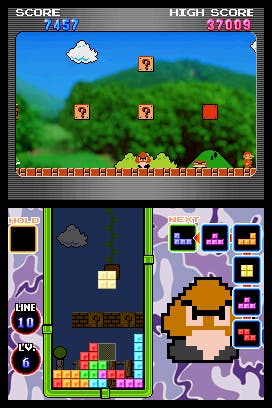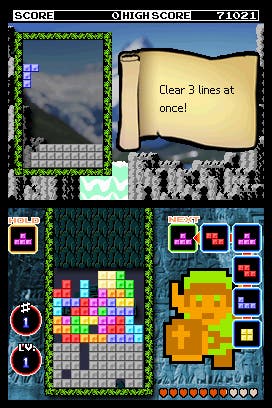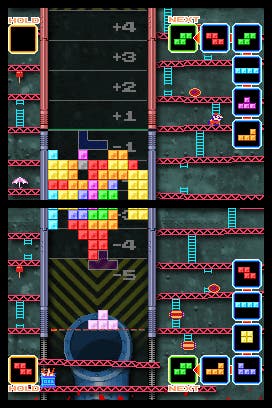Tetris DS
Tetrissimo or Tetritis?
Not so long ago, seeing "Tetris DS" on the release calendar would have provoked a pretty uniform response. "There they go again." "Another pointless cash-in." Etc. (And, I suppose, "What the hell is a DS?")
Those were the dark days of GBA (very dark days unless you had a light add-on) when Nintendo's portable gaming strategy was "look in cupboard, put in new box, charge £30". It was jolly nice for reviewers getting Mario Bros. 3, Yoshi's Island, Zelda 3 and a nice new broom through the post every other month, but you lot were getting ripped off, frankly, and you knew it. It was even worse when it came to multiplayer - GBA games could happily support single-cartridge multiplayer, but Nintendo and its friends went for "wring another £30 out of them" instead, and didn't bother with it most of the time.
Things are different now, of course. Portable gaming is exciting again. Perhaps it's because Nintendo ran out of stuff in the cupboard, perhaps it's because Sony provoked them, but whatever the reason, an old name means a new game with new thinking behind it, and we're not arguing. So it is that Tetris DS has five entirely new gameplay modes, and you can play it with nine other people using just one copy or go on the Internet and play against friends or complete strangers.
Before we get onto the new stuff though, it's worth paying tribute to old-days Tetris, which is offered here as "Standard" mode - and it's doubly worth mentioning because old-days Tetris isn't quite the same as it was 20 years ago.
For a start, it now has Mario, Link, Samus and other Nintendo pals dancing around on the top screen while you try and create rows by organising blocks as they descend down the rectangular play area. Every time you complete the ten rows that make up a level and the speed increases, new friends pop up with familiar Nintendo tunes - until you hit level 20, when it all circles back round again if you're playing "endless" mode, or you get a victory screen and staff credits if you're playing plain old "marathon".

But, more importantly, the way Tetris works is subtly different - you can set an option that traces an outline where the block will fall, which makes things easier (there's also an option that makes "up" on the d-pad slam the block down instantly wherever you've positioned it), and instead of having to rotate the block quickly as it's descending you can now endlessly hit A or B to rotate it once it's on the bottom. In this way, you can actually walk certain blocks across the top of whatever you've already put together. As a result, hitting level 20 and beyond is very easy relative to how it was back in the day. The shoulder button on the DS also makes it easier to "store" a block (the straight line being the obvious one to cache), while you're also shown what's going to descend several lines in the future rather than just what's next.
Despite initial reservations though, this new standardised Tetris model remains compulsive, and stuck in endless mode it takes on a rather different challenge as you frantically rotate blocks trying to keep them "alive" while you work out what's going on. Hitting levels above 50 isn't unheard of, which would have sounded ridiculous back in the days of ‘80s Tetris.
Also part of the standard mode is the line-clear option, which gives you a pre-jumbled bunch of blocks to clear with gaps in odd places, and tasks you with getting rid of them. Old-days Tetris had this too, and it used to be the best way to get "closure", but although it's still fun there's so much else on the cart that you probably won't play it all that much except for a sense of completion.
Because while none of the five new game modes feels essential enough that you'll turn to them before the standard mode, there are some very different challenges here that prove fiendish and fairly addictive in their own ways.
Push is probably the most fun (and one of the few things you can do multiplayer beyond standard Tetris). Here the action is split between you on the touch-screen and an opponent (CPU or otherwise) on the top, and you're actually playing a sort of reverse tug-of-war in the same area. A few blocks centred between you anchor your contributions, and the more rows you complete the farther your opponent is pushed back toward a fiery danger zone. Push him all the way and you win.

Touch mode is the most DS-focused of the lot - most of them don't require the stylus at all, but Touch is about nothing but stylus use. Faced with a tower of blocks reaching well up beyond the ceiling of the top screen, your job is to manoeuvre the ones on the bottom from side to side using the stylus to try and create rows. Deprived of the option to move them up or down (or rotate them, which you can only do on the lower skill levels, and even then only when there's enough room), you have to think quite a bit ahead.
Similarly cerebral is Puzzle mode, which is made up of 200 pre-arranged sets of Tetris blocks. You're not up against a clock, cramped conditions or the rate of descent here at all; the idea is to pick one of the three or more blocks offered on the touch-screen and then select an orientation, and if their introduction can clear a row then they'll scoot down into the mess of blocks on the top-screen. This is simple enough, but making sure you pick them in the right order and the right orientation is a question of planning rather than luck.
Mission mode is more like proper Tetris, albeit with Zelda styling. Here you're tasked with doing various things against the clock - clearing three lines at once, clearing two lines using a certain kind of block, and so on - and failure to do so is penalised by the insertion of various unhelpful blocks beneath the ones you're working with. You can try and wipe them away by slotting in blocks outside the bounds of your current task, but you're always fighting the clock, which makes things more difficult.
Finally there's the Metroid-themed Catch, which is another endless mode but quite unlike normal Tetris in that instead of rotating the falling blocks, you rotate the cluster you're creating with them. The play area is naturally wider, and blocks fall in different areas and out of your control. Your job is to rotate and snap them on to the shape you're creating; do so neatly enough to create a solid cluster four or more blocks across and you can detonate them to make space, with a short period prior to the explosion during which you can try and snap on more of the descending blocks to bank more points. Meanwhile, you're trying to preserve a health bar, which diminishes if you let blocks slip off the bottom, if you strike them clumsily during a rotation, or if you run into Metroid enemies that totter unhelpfully down the screen alongside the blocks you need.

All of which tedious explanation leaves us with the question of whether the new modes are any good - and the answer is "sort of". Push, which is frantic in multiplayer, is an excellent addition and probably the best of the bunch, and the others are variously a bit obvious, fiddly or unremarkable. Touch and Puzzle are good, solid time-wasters, but you won't enjoy the same exciting sparks of inspiration that you do playing Polarium's puzzle mode or even Lumines's equivalent, while Puzzle itself is initially a bit vulnerable to tedious substitution methods. Still, Mission is satisfying, and certainly helps develop your Tetris instincts, so that's a pass, and the way Catch turns things on their head (and side, and feet again) is immediately engaging, although seems unlikely to prove as enduring as the game that spawned it.
The problem the new modes face, of course, is their inevitable comparison to a game that's echoed throughout the genre for two entire decades. They are certainly welcome, but do, by necessity as much as definition, feel a bit derivative.
Nevertheless Tetris DS is a success. Not only is it quite cheap and full of play options, it offers something more than any previous Tetris game in its ten-player mode. Naturally you're going to struggle to get ten people together, but however many you do it's a furious pleasure. Likewise, playing over the Internet is a decisive joy - Wi-Fi Connection endured a bit of criticism when Mario Kart was the headliner, but here, particularly played against friends of a similar skill level, it's alarmingly moreish. As ever, the emphasis is on clearing multiple rows at once, preferably the maximum of four, and the reward for doing so is shoving grey blocks up underneath your opponent. It's simple, but it never seems to get old - and fighting back with a well-placed straight line into the heart of the grey blocks your opponent's just stuck you with is as delicious a comeback as any of Mario Kart's variously coloured shells.
There will be complaints that you can't turn off the things that have changed about Tetris since it was the main reason to own a Game Boy - namely the store option and ability to see six pieces in advance - and for those without the ability to take their DS online, it's slightly less essential - the new modes are fun but the old one is still the most important. Regardless, this feels as welcome as any of Nintendo's recent DS reworkings, and, given that I had to pay for my own copy, I feel like I can say that with a bit more conviction than I ever did when heaping guilty praise on GBA releases. It's "Tetris with the Nintendo touch!" the box declares. Touché.


